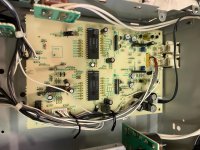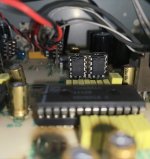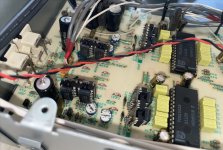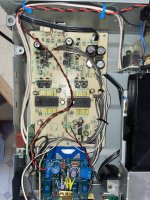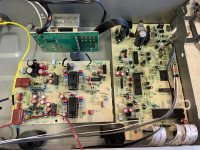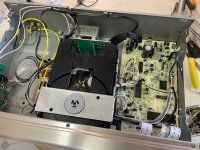Hi! So I think I've searched enough that this isn't duplicate
Going to me more Howie Didit, than my usual ramblings, but there you are. "If only one CD-Z is saved it will have been worth it"
So Teac's CD-Z500 (or CD-Z 5000) nice player frankly with two times TDA1541A = one for each channel
Best of all it has a discrete 'doing all the CD stuff' board and a 'doing all the audio stuff' board (technically there is some clock handshaking betwixt the two but meh
FIRST OF ALL ok it has TDA1541A's in parallel - if you need a moment to yourself after hearing that, take a shower & wipe your self off before reading on
This is just for fun OK? no one died
Typically I didn't take any photos of the outside but armed with this very websites version of the truth (special mention to Pedja Rogic) I did the standard version one mods replace all electrolytics and add decoupling caps for the TDA1541A's as suggested
And you know what?
It's become my daily. Pretty sure I own at least one CD player that is technically better but I turn this on, it makes music and I like it
Yes output op amps came along: SIL yes, thanks for that Teac,
TBH it gas been a few years since I 'did' the first one. but see pics
more to come from the last iteration FYI
Andy

Going to me more Howie Didit, than my usual ramblings, but there you are. "If only one CD-Z is saved it will have been worth it"
So Teac's CD-Z500 (or CD-Z 5000) nice player frankly with two times TDA1541A = one for each channel
Best of all it has a discrete 'doing all the CD stuff' board and a 'doing all the audio stuff' board (technically there is some clock handshaking betwixt the two but meh
FIRST OF ALL ok it has TDA1541A's in parallel - if you need a moment to yourself after hearing that, take a shower & wipe your self off before reading on
This is just for fun OK? no one died
Typically I didn't take any photos of the outside but armed with this very websites version of the truth (special mention to Pedja Rogic) I did the standard version one mods replace all electrolytics and add decoupling caps for the TDA1541A's as suggested
And you know what?
It's become my daily. Pretty sure I own at least one CD player that is technically better but I turn this on, it makes music and I like it
Yes output op amps came along: SIL yes, thanks for that Teac,
TBH it gas been a few years since I 'did' the first one. but see pics
more to come from the last iteration FYI
Andy
Attachments
Last edited:
Suppose I better explain the mods I've undertaken and share the little earth fun that took some figuring out.
So Mk1 - concentrating mostly on the Audio board (At this point I was a little full of trepidation around the digital side. However the cd-400 / cd-p4000 share the same front end as far as I can see)
I wouldn't do it this way again but this player has seen off some competition over the years, long after the proud father thing wore off
Andy
So Mk1 - concentrating mostly on the Audio board (At this point I was a little full of trepidation around the digital side. However the cd-400 / cd-p4000 share the same front end as far as I can see)
- Naturally Electrolytic caps replaced because "old" and it has become my default position.
- I do like a good socket! I appreciate it's not good practice to unsolder any chip, only to add a weak link between it and the board
- SIL op amps swapped out using Browndog adaptors (really went all in on the sockets here!). I forget the logic but there's a mix of AD797 and AD845's (the 797's for the I/V bit)
- DEM caps simply swapped out to 0.22uf as per Marantz 'top' models
- An error the oscillator cap that should be 470p is 470n - don't know the effect, it works, its wrong, it'll probably get swapped out
- Changed the fixed audio output to a better but equivalent phono socket - this turns out is important 🙂
- Output caps changed to some Visaton ones, again logic for that long forgotten, they may even be non-polar :-o
- Clock 'upgraded' a simple kit, that has 5v regulator etc onboard but allows a TCXO
I wouldn't do it this way again but this player has seen off some competition over the years, long after the proud father thing wore off
Andy
Attachments
The best modifications in early CD are which are focused the right CD reading without problems, skips, etc...
I hate all this kind of modifications replacing op-amps and CDs that does not have any real improve in CD player performance.
Maybe the enthusiast pass a funny time replacing these components, and maybe believes that sounds better, but the king is naked, and nothing of this happens. Moreover, I ve seen a lot of problems and failures due by this mods.
If it works, don't touch this.
Two TDA1541A better than one, Cambridge Audio make a cd player with four or eight TDA1541. It sounded better? No.
Get out from audio miths and enter in the real electronic facts.
I hate all this kind of modifications replacing op-amps and CDs that does not have any real improve in CD player performance.
Maybe the enthusiast pass a funny time replacing these components, and maybe believes that sounds better, but the king is naked, and nothing of this happens. Moreover, I ve seen a lot of problems and failures due by this mods.
If it works, don't touch this.
Two TDA1541A better than one, Cambridge Audio make a cd player with four or eight TDA1541. It sounded better? No.
Get out from audio miths and enter in the real electronic facts.
Heh you're gonna hate the next bit then 😀
Naturally I will defend myself a bit with some scientific 'facts'.
I've read your other posts now. "not broke don't fix" is really a thing
Lastly, I didn't say two DACs were better than one or less good than 4 - Sony and Philips (Marantz) did. Obviously, they don't have your grasp of the format though.
Of course I'm just playing, there's no scientific method to audio as far as I can see - see how I completely and intentionally mess up the Mk2 😀
Andy
Naturally I will defend myself a bit with some scientific 'facts'.
- Electrolytic capacitors dry out with age, so replacing them is an inexpensive step. Offering no benefit other than return to original specification.
- There has been MUCH written on other capacitors around the TDA1541A, again probably makes little difference but low cost so why not?
- Changing op amps - again its debatable but higher PSRR, faster slew rate lower input drive etc. seems good? How that sounds? insignificant in terms of the colouration of your amp and speakers I would guess.
Not exactly the theme here is it? By all means lets discuss why they are bad mods (and they are) But "you believe one thing and I believe another" (with the unit in front of me) isn't really a thingIf it works, don't touch this
I've read your other posts now. "not broke don't fix" is really a thing
Lastly, I didn't say two DACs were better than one or less good than 4 - Sony and Philips (Marantz) did. Obviously, they don't have your grasp of the format though.
Of course I'm just playing, there's no scientific method to audio as far as I can see - see how I completely and intentionally mess up the Mk2 😀
Andy
Ok. One question, you have replaced the output Op-Amps, now, if you don't have audio instrumentation, how do you adjust harmonic distortion? Because, with other Op-Amps, the adjust is different. I'm talking about point 4 in adjust procedure, page 4-10. I think that, if you are looking for the most perfection, this step is very important.
🙂 Is it though?this step is very important.
We don't take a THD meter to the shop. We listen, and see if we like it.
To be honest, I've left it for now (because I like how it sounds at the moment) but I'll get to it of course, normally use a PC based approach. No adjustment without meter in that regard
With all the modifications, what do you really want?
It's suppose all this stuff is for to improve its performance, quality sound mainly. But, if after all, you don't adjust THD potentiometers. Does it have all this mods any sense?
I've ajusted THD adjustement in only one CD, when you touch the pots you don't notice nothing, but the audio analyzer meassues dramatic changes in THD. It was the Luxman DZ-111. THD in service manual is 0,008%, I left it with 0,007%.
It's suppose all this stuff is for to improve its performance, quality sound mainly. But, if after all, you don't adjust THD potentiometers. Does it have all this mods any sense?
I've ajusted THD adjustement in only one CD, when you touch the pots you don't notice nothing, but the audio analyzer meassues dramatic changes in THD. It was the Luxman DZ-111. THD in service manual is 0,008%, I left it with 0,007%.
Hi ManiloMos
That's sort of my point 0.009% or 0.09% is tiny vs the rest of real life. - people still listen to records 🙂
As far as I can see the pots just attempt to balance the output of the DAC IV to the summing amp, IMHO there might be a good argument for using a (singular) good quality multi-turn pot, rather than a pot, a resistor then another pot.
Andy
That's sort of my point 0.009% or 0.09% is tiny vs the rest of real life. - people still listen to records 🙂
As far as I can see the pots just attempt to balance the output of the DAC IV to the summing amp, IMHO there might be a good argument for using a (singular) good quality multi-turn pot, rather than a pot, a resistor then another pot.
Andy
So to part two
I managed to get a second CD-500 so what to do? Of course at this point I'm happy with the 'original and worst' but MORE 😀
So same "technique" as before:
Andy
I managed to get a second CD-500 so what to do? Of course at this point I'm happy with the 'original and worst' but MORE 😀
So same "technique" as before:
- All Electrolytics out and replaced on the audio board - and more on the PSU / digital board than before
- All of the ceramic caps are gone now replaced with Wima or polystyrene
- DEM caps - after looking at Marantz, Arcam and Rojic and so on. Compromised by space available on the Teac board the MSB cap is "only" 1uF rather than 4uF. However, taking Marantz as the reference I'm Ok with that.
- OP-Amps swapped with SMD types on the SIL sockets.
- Belts for the mech changed of course
- Moved the audio board ?!?
- Lost the variable output - that will have implications later
- Changed the Phono Plugs to gold plated "proper plugs"
- Output caps changed to film types
Andy
Attachments
So on the phono plug "upgrade" necessitated by moving the board, causes PROPER problems. At this stage I had tested the CD player to ensure that nothing had gone too wrong after all the fiddling.
All fine nothing to report
Until I try the player in isolation - Nothing DEAD, no disk spinning for all the world looked like a drive fail...
Some Time Later....
Turns out that the earth reference for the audio board - and hence the clock, is through the chassis. If signal earth isn't linked to the chassis. No dice. So any loss of earth on the chassis and goodnight Vienna!
Seems a dubious earthing practice to me after all the other efforts. There is no special measure taken to link the signal earth to the chassis and hence to digital earth. Mind you connect it to any other device and "all is good"
Note on the CD-Z5000 this potential failure path, according to the service manual anyway seems to have been fixed with wires - I did the same.
All fine nothing to report
Until I try the player in isolation - Nothing DEAD, no disk spinning for all the world looked like a drive fail...
Some Time Later....
Turns out that the earth reference for the audio board - and hence the clock, is through the chassis. If signal earth isn't linked to the chassis. No dice. So any loss of earth on the chassis and goodnight Vienna!
Seems a dubious earthing practice to me after all the other efforts. There is no special measure taken to link the signal earth to the chassis and hence to digital earth. Mind you connect it to any other device and "all is good"
Note on the CD-Z5000 this potential failure path, according to the service manual anyway seems to have been fixed with wires - I did the same.
Well why would I want that extra space? you might ask 🙂
A tube buffer of course.
I thought a lot about this one - not saying you'll agree but ended up with an X10-D clone - easy to implement and it has become, for better or worse, the tube CD sound. Whatever that is.
YES I know all of the arguments against X10D, Heard them, understood them and yet here we are...
Alternatives were a 5670 cathode follower or SY's heretical unity gain stage (if only there was a board for that) The charms of SY's solution are huge but yet unvisited - no big caps in the output.
you can skip the original output caps with the "X10D clone thing" as it has its own. I removed the input resistors so that big 10Uf cap at the output is shrunk to 0.22uF. I'm feeding it from the input side of C131 and C231 picking earth up from the redundant variable O/P connector
I also tweaked the clone to have a film cap in the feedback loop (C105) rather than an electrolytic. Piffling change but felt better with caps in the audio path being film - cost less than a fiver...
Andy
A tube buffer of course.
I thought a lot about this one - not saying you'll agree but ended up with an X10-D clone - easy to implement and it has become, for better or worse, the tube CD sound. Whatever that is.
YES I know all of the arguments against X10D, Heard them, understood them and yet here we are...
Alternatives were a 5670 cathode follower or SY's heretical unity gain stage (if only there was a board for that) The charms of SY's solution are huge but yet unvisited - no big caps in the output.
you can skip the original output caps with the "X10D clone thing" as it has its own. I removed the input resistors so that big 10Uf cap at the output is shrunk to 0.22uF. I'm feeding it from the input side of C131 and C231 picking earth up from the redundant variable O/P connector
I also tweaked the clone to have a film cap in the feedback loop (C105) rather than an electrolytic. Piffling change but felt better with caps in the audio path being film - cost less than a fiver...
Andy
Yes, this is good motif, but it should be you could see the signals with some kind of instrumental. Ears and mind are not impartials, you can be affected for all stuff written on internet. For that, see the signals by yourself. Double blind test is your best friend.
And, don't forget don't use solid capacitors for coupling circuits.
https://www.elna.co.jp/en/capacitor/alumi/catalog/pdf/0-caution_HV_e.pdf
And, don't forget don't use solid capacitors for coupling circuits.
https://www.elna.co.jp/en/capacitor/alumi/catalog/pdf/0-caution_HV_e.pdf
Ok so we can agree - "Proud father" syndrome is a danger. I know I just added a bunch if second harmonics (at least i expect that when measured) with the tube stage. Because I can switch between the two I'll claim my ears are impartial. I can't hear a quantifiable difference immediately, but over hours I have a preference.
Thank you for the link.
Thank you for the link.
Taking in consideration your inclinations in audio, maybe it could be good you had a an audio analyzer. Expensive, or cheap. In this forum you can find threads about audio analyzers with audio cards in PCs.
An audio analyzer is a great tool for to see all data and graphics in your audio experiments. Your ears are your best tool for to hear music, not for to measure hi-fi.
My experience about armonics in transistors and tubes is low, but I've seen in tube amplifiers that armonics, even and odd(Is it right said?) armonics, are almost at the same level, while in bipolar transistors, are odd armonics. Said in other words, tube amplifiers has even armonics too.
For to experimentize, it could good for you to take a DAC, it's preferible than a CD player.
And, the last, don't forget emphasis de-emphasis circuits that some CD or DAC has.
An audio analyzer is a great tool for to see all data and graphics in your audio experiments. Your ears are your best tool for to hear music, not for to measure hi-fi.
My experience about armonics in transistors and tubes is low, but I've seen in tube amplifiers that armonics, even and odd(Is it right said?) armonics, are almost at the same level, while in bipolar transistors, are odd armonics. Said in other words, tube amplifiers has even armonics too.
For to experimentize, it could good for you to take a DAC, it's preferible than a CD player.
And, the last, don't forget emphasis de-emphasis circuits that some CD or DAC has.
- Home
- Source & Line
- Digital Source
- TEAC-Z500 or CDP-400 or CD-Z4000 etc and modifications to same - Dual TDA1541A
